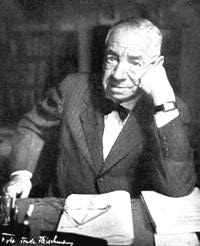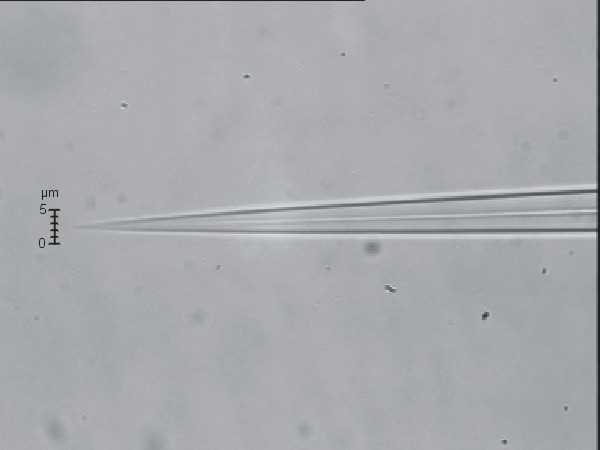

 In the first decades
of the 20th century, research about the chemical mediation of action in the autonomous, or vegetative nervous system,
how it was then called, was developing at a feverish pace in many laboratories in the world. The main centers were
located in England, where William
Maddock Bayliss (1860-1924), Ernest Henry Starling (1866-1927), Henry Dale and T.R. Elliot were investigating the actions
and properties of this system and the then recently identified acetylcholine and adrenaline. Otto Loewi, who was
a professor of physiology in Vienna, Austria, spent in 1902 a time visiting Starling´s and Dale´s laboratories,
and got the idea of doing research on chemical transmission.
In the first decades
of the 20th century, research about the chemical mediation of action in the autonomous, or vegetative nervous system,
how it was then called, was developing at a feverish pace in many laboratories in the world. The main centers were
located in England, where William
Maddock Bayliss (1860-1924), Ernest Henry Starling (1866-1927), Henry Dale and T.R. Elliot were investigating the actions
and properties of this system and the then recently identified acetylcholine and adrenaline. Otto Loewi, who was
a professor of physiology in Vienna, Austria, spent in 1902 a time visiting Starling´s and Dale´s laboratories,
and got the idea of doing research on chemical transmission.
After working 12 years on the pharmacology of the Autonomous Nervous System, now in the University of Graz, Austria, he devised the crucial experiment which provided the first reliable evidence for the existence of chemical transmission in a synapse. The legend tells that he had the idea of the experiment in a dream and that he ran to the lab as soon as he was awake.
Otto Loewi´s experiment (1921) T = time S = stimulus in the vagus D = contractions of heart D R = contractions of heart R Loewi´s original kimographic record of the experiment. |
The experiment was very simple and became a prototype
for all investigations of humoral (i.e., chemical) factors in the nervous system. He cut out two hearts from frogs
and perfused them with a warm physiological solution (Ringer). In this condition, the frog´s hearts continue
to beat for some hours. He then stimulated the vagus nerve to one of the hearts. As a consequence (R), there was a strong inhibition in this heart beats. The second heart (D) was unaffected. However, when he perfused the second heart with the outflow of the perfusion
of the first one, he achieved exactly the same effect, with a small delay provoked by the pump action and the chemical
action. The only fact that could explain this result was that there was some substance being produced at the parasympathetic synapse level in heart R, which had the power to provoke a similar response in the muscles of heart D. Loewi called this substance Vagusstoff (vagal substance). He was almost certain that it was acetylcholine, how was proved later, but he was cautious in the beginning. After using the same preparation to study the effects of stimulating the sympathetic nerves to the heart, he obtained an opposite effect: heart D accelerated its pace, very much like injected adrenaline (later it was identified as being a similar molecule, named noradrenaline). With the same caution, he called this Acceleransstoff (accelerating substance). He also coined the term "neurohumoral transmission" to explain what he found. |
"According to this relatively new evidence, a chemical mechanism of transmission is concerned, not only with the effects of autonomic nerves, but with the whole of the efferent activities of the peripheral nervous system, whether voluntary or involuntary in function" [Dale, 1936]
Dale also was the first to isolate acetylcholine from mammalian organs, and to propose the terms "cholinergic" and "adrenergic" synapses
Loewi and Dale, who were friends since 1906, continued their efforts on clarifying the role of neurotransmitters. They shared the Nobel Prize of 1936 for their discoveries.
Synapses continued to be studied from many angles by physiologists and pharmacologists. However, real progress started to be made only when microelectrodes with very thin points could be manufactured. In this manner, they could be inserted in the near proximity of such small structures as synapses, and used to study their electrophysiology. It was Sir John Carew Eccles (1903-1997), an Australian from Melbourne, who was the pioneer in this area.
|
|
|
|
|
Eccles started by studying the neuromuscular junction, the specialized synapse between motor neurons and muscles. This was a favourite subject of early synaptologists, because it was big, access to it was easy, and isolated preparations could be mounted with little effort. Eccles, in the beginning of his research career, while he was working in Oxford (1934 to 1937), believed that synapses had electrical transmission and resisted the idea of a chemical transmission proposed by Sir Henry Dale and his followers.
But soon, another researcher, Bernard Katz, was able to study the neuromuscular junction with intracellular electrodes, and the role of acetylcholine in this synapse was completely demonstrated. Katz and his coworkers discovered that the small fluctuations in in the base membrane potential recorded at the neuromuscular junction were due to the random release of synaptic vesicles containing acetylcholine, and the study of its mechanism, "quantal release" by Katz, was elucidated and integrated with the results obtained with electron microscopy.
After returning to Australia, in 1951, Eccles succeeded for the first time in inserting microelectrodes into nerve cells of the central nervous system and in recording the electrical responses produced by synapses. He discovered what was being predicted by Sir Charles S. Sherrington from his reflex studies: there were two kinds of graded potential responses in the post-synaptic elements, when excited by the release of neurotransmitters: the excitatory and inhibitory post-synaptic potentials (EPSP and IPSP, respectively). Eccles was later instrumental in researching the ionic basis of membrane potentials in the synapse, studying sodium, potassium and calcium.

Ultrafine tipped glass microelectrode is filled with conducting fluid. The scale is 5 micrometers. |

A glass micropipette puller apparatus |
Sir John Eccles and Sir Bernard Katz were both honoured with the Nobel Award of 1963 and 1970, respectively.
The discovery that the transmitter acting in adrenergic synapses was not adrenaline, as it was supposed, but rather a correlated substance called noradrenaline was made by the Swedish researcher Ulf Von Euler (1905-1983), and its metabolism extensively studied by American researcher Julis Axelrod (1912-). Both shared with Katz the 1970 Nobel award.
The discovery of how the nervous system is organized and works at the cellular level is one of the most fascinating of the history of science. It started with a powerful new concept, that of bioelectricity, but actually without any real knowledge how it was generated, because we must remember that until 1838, we ignored that all organisms were made of cells and how the different filament processes which were being seen in histological sections related to the so-called "globules" in the tissue. Scientific progress was very slow at the time, because it was hindered by technical drawbacks. For example, it took half a century (from 1838 to 1888) to change the view that the nervous system was not a giant network (the reticularist hypotheses) to the conventional idea that neurons are individual cells like in most of the other tissues of the body (the neuron doctrine).
In retrospect, the three long "plateaus" of little progress between giant and sudden steps where due mainly to technological reasons. The first big step (discovering neurons, dendrites and axons), were due to the invention of the achromatic microscope. The second big step (discovering that neurons do not fuse, and that dendrites and axons belong to them) occurred because novel staining techniques, such as Golgi´s method, were developed. The third big step was achieved only when microelectrophysiological techniques (and the use of glass microelectrodes, high-gain electronic amplifiers and oscilloscopes) and the electronic microscope, were conquered.
|
Neurons and Synapses: The History of Its Discovery Part 5 of 6 Published on 23.Feb.2003 |
 |